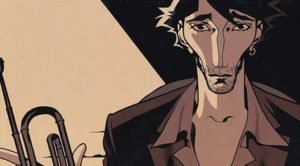Writer: Jonathan Hickman
Artist: Esad Ribić
Marvel Comics / 20th Century Studios, December 2024

How appropriate that we publish a review on a sci-fi / horror / superhero story on Halloween.
It should be no surprise that for such a monumental crossover like Aliens v Avengers, superhero butter churn Marvel Comics and motion picture studio 20th Century (sans Fox) have deployed the creative big guns. Here is Marvel Comics’ very short promotional blurb:
ALIENS AND AVENGERS FACE OFF! It’s all led to this: Xenomorphs reach Earth! The perfect organism meets a planet of superhumans. Who will be first to fall? Legendary collaborators Jonathan Hickman and Esad Ribić cut loose in this four-part epic unmissable for Marvel and Alien fans alike!
We have written about Jonathan Hickman’s body of work many times. It is fair to say that amongst contemporary American comic book writers, Mr Hickman is rivalled in quality only by Rick Remender. Somehow however we have not in any of our critiques for the past ten years mentioned Esad Ribić, one of the foremost photographic realism comic book artists of the day. In this first issue, neither of these masters let the reader down. Even Mr Hickman’s exposition, meandering through six pages of this first issue, is high quality dross.

The first three pages consists of one of Mr Hickman’s stock juxtapositions (which we saw repeatedly in his title, East of West): philosophical dialogue intermingled with brutality. By the time we reach the end of this first issue, the fine words have been replaced with the clipped language of survival.
The plot is inevitable. Xenomorphs, featured in so many motion pictures since Ridley Scott’s groundbreaking 1979 film Alien, have been seeded onto the Earth and have laid waste to the planet. The story is set perhaps 30 years in the future, and so is firmly out-of-continuity with the cinematic franchise. There are some indicia: We see Weyland Yutani’s corporate headquarters in what we assume is New York (Aliens v Avengers‘ cover logo is in fact Weyland Yutani’s corporate logo, inverted), and we have a treacherous android bleeding grey blood, both staples of the Alien franchise.
But, otherwise, the story is an Avengers story. We have seen the elderly Avengers of future epochs many times in other titles (see for example Old Man Logan and Old Man Hawkeye, and more recently, Avengers: Twlight – see Avengers: Twilight #1 (review) – World Comic Book Review ). Here as elsewhere they are heavy set, deeply wrinkled, and looking frayed from the ongoing catastrophe: the Hulk still looks the same, but his alter ego Bruce Banner looks worse for wear aged around 75.

Another mainstay of the Marvel Comics’ panoply of characters, Captain Marvel, looks to be around 60, and Valeria Richards, the daughter of two members of the Fantastic Four, describes herself as “a 45 year old woman, who has been divorced twice”. Miles Morales, who is Spider-Man, is wearing his mask at all times in this issue so we can’t pick his apparent age. Quickly, however, his mask is not all he is wearing.

While the Aliens franchise concentrates on the inherently amoral commercial behaviour of the Weyland-Yutani corporation, this title instead delves into Marvel’s space history. Part of the point of Alien and its sequels is to draw an analogy between the xenomorphs’ “eat-breed-lay waste” existence and that of corporations.
With no corporations lurking about in this title, Mr Hickman instead looks to Marvel’s various galactic empires – the Kree, the Skrulls, the Spartax, and the Shi’ar. The Shiár are initially apparently responsible for spreading the xenomorphs amongst inhabited planets. This does not quite work. Empires are callous hierachies, ordinarily, not victims. (One of the pleasing elements of this however is to learn that the fictional African nation of Wakanda now has its own small space-faring empire, bringing the Black Panther and his son into the plot.)
Within the Weyland building back on Earth, however, is a man in a wheelchair who we have assumed is an aged Iron Man. But on a re-reading it is not made clear. Certainly Bruce Banner is not especially friendly towards him. Could this character instead be Weyland-Yutani’s founder, Charles Bishop Weyland? Has he commissioned the androids to spread xenomorphs across the galaxy? Perhaps more corporate skullduggery is actually to come.
Mr Ribić’s art cannot be flawed. He catches the leathered faces of the main characters, the folds of their skin reflecting shadow and the habitual expressions. In addition, Alien‘s grey gloom of greasy pipes and other large modern features of gritty industry haunt Mr Ribić’s backgrounds with realistic authenticity.
Where to from here? The Earth seems doomed. It seems that, like the mutants of the X-Men, off-planet is the way to go. The urgency to evacuate the Earth gives the title suspense. But to where? We look forward to the next three issues of this four-parter.


